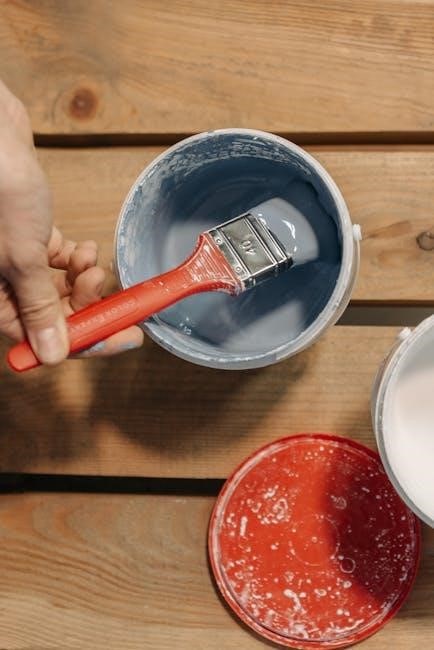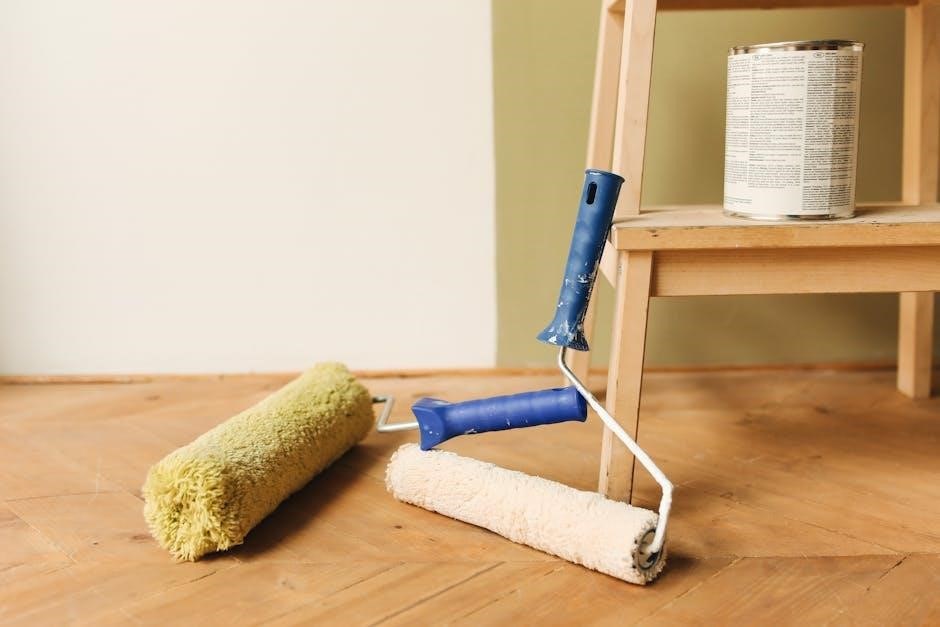readers digest complete do it yourself manual
The Reader’s Digest Complete Do-It-Yourself Manual is a trusted guide for home improvement, offering detailed instructions and color illustrations for various projects, from plumbing to woodworking, since 1973.
Overview of the Manual
The Reader’s Digest Complete Do-It-Yourself Manual is a comprehensive guide designed to empower individuals with the knowledge and skills to tackle a wide variety of DIY projects. Whether you’re a seasoned DIY enthusiast or a beginner, this manual provides detailed instructions, practical advice, and creative solutions for home improvement, woodworking, gardening, and more. The manual is organized into clear sections, covering everything from essential tools and safety tips to advanced renovation techniques. Each chapter is filled with step-by-step guides, accompanied by illustrations and diagrams to ensure clarity. The manual also emphasizes sustainability and cost-effectiveness, offering tips on repurposing materials and saving money. With its user-friendly approach and extensive coverage, it serves as an indispensable resource for anyone looking to enhance their home and develop new skills. It’s a must-have for every DIY enthusiast.
History and Evolution of the Manual
The Reader’s Digest Complete Do-It-Yourself Manual has a rich history, first published in 1973 as a response to the growing interest in DIY projects. It quickly became a trusted resource, offering practical solutions for homeowners. Over the years, the manual has evolved to reflect advancements in technology, changes in safety standards, and the introduction of new materials. Each edition has been updated to address contemporary challenges and incorporate feedback from readers. The manual has also expanded its scope to include modern projects, such as energy-efficient upgrades and smart home improvements. Its enduring popularity lies in its ability to adapt while maintaining its core mission of empowering individuals to take control of their home improvement needs. Today, it remains a cornerstone of DIY literature, celebrated for its timeless advice and forward-thinking approach.
Why It’s a Trusted Resource for DIY Enthusiasts
The Reader’s Digest Complete Do-It-Yourself Manual is widely regarded as a trusted resource for DIY enthusiasts due to its comprehensive and detailed guidance. It covers a vast range of projects, from simple repairs to complex renovations, ensuring that both beginners and experienced DIYers find value in its pages. The manual is known for its clear, step-by-step instructions, accompanied by diagrams and illustrations that make even the most daunting tasks manageable. Its focus on safety, practicality, and cost-effectiveness has earned it a loyal following. Additionally, the manual is regularly updated to reflect the latest techniques, tools, and materials, keeping it relevant for modern DIY projects. This combination of reliability, accessibility, and expertise solidifies its reputation as an indispensable guide for anyone tackling home improvement tasks.

Tools and Safety
The manual emphasizes the importance of proper tools and safety measures, guiding readers to choose the right equipment and understand essential precautions for successful DIY projects.
Essential Tools for Every DIY Project
The Reader’s Digest Complete Do-It-Yourself Manual highlights the importance of having the right tools for any project. It recommends starting with basic tools like a hammer, screwdrivers, pliers, and a tape measure. Power tools, such as drills and sanders, are also essential for more complex tasks. The manual emphasizes the value of hand tools, including wrenches, utility knives, and levels, which are indispensable for precise work. Additionally, it advises keeping a well-stocked toolbox with fasteners, adhesives, and safety gear like gloves and goggles. By investing in quality tools and organizing them properly, DIY enthusiasts can tackle projects efficiently and safely. The manual provides detailed lists and tips for selecting the best tools for various tasks, ensuring readers are well-prepared for any DIY endeavor.
Safety Precautions and Best Practices
The Reader’s Digest Complete Do-It-Yourself Manual stresses the importance of safety in every project. It outlines essential precautions to prevent accidents, such as turning off power sources before starting electrical work and using personal protective equipment like gloves and safety glasses. The manual advises clearing workspaces of clutter and ensuring proper ventilation when using chemicals. It also emphasizes the need for fire safety, recommending the presence of a fire extinguisher nearby. Additionally, it warns against overconfidence and urges readers to follow manufacturer instructions for tools and materials. The guide provides tips for working at heights, such as using sturdy ladders and securing them properly. By prioritizing safety, DIY enthusiasts can avoid injuries and ensure successful outcomes for their projects. The manual’s focus on best practices helps readers maintain a safe and efficient workspace.

Home Repair and Maintenance

This section provides comprehensive guidance on maintaining and repairing your home, covering interior and exterior fixes, and essential tips for preventing damage and extending longevity.
Interior Repairs: Walls, Floors, and Ceilings
The Reader’s Digest Complete Do-It-Yourself Manual offers detailed guidance for tackling common interior repairs. From patching cracks in walls to fixing creaky floors, the manual provides step-by-step instructions. Learn how to assess damage, prepare surfaces, and apply the right materials for a seamless finish. For floors, discover techniques to repair hardwood, tile, and carpet damages, ensuring stability and safety. Ceilings are also covered, with tips on addressing water stains, cracks, or sagging areas. The section emphasizes the importance of addressing issues early to prevent further deterioration. Whether you’re a novice or an experienced DIYer, this guide equips you with the skills to restore your home’s interior to its original condition.
Exterior Repairs: Roofs, Siding, and Foundations
The Reader’s Digest Complete Do-It-Yourself Manual provides comprehensive guidance for exterior repairs, ensuring your home’s structural integrity and curb appeal. For roofs, learn to identify and fix damaged or missing shingles, leaked flashing, and sagging areas. The manual offers tips on inspecting for wear, repairing leaks, and maintaining gutter systems to prevent water damage. Siding repairs are also covered, from replacing loose panels to addressing rot or dents in vinyl, wood, or brick exteriors. Additionally, the section addresses foundation issues, such as cracks, uneven settling, or water seepage. Easy-to-follow instructions help homeowners assess and fix these problems, ensuring long-term stability. With clear diagrams and practical advice, this guide empowers DIYers to tackle exterior repairs confidently and effectively, preserving their home’s value and safety.
Plumbing Basics and Common Fixes
The Reader’s Digest Complete Do-It-Yourself Manual offers a detailed guide to plumbing basics and common fixes, empowering homeowners to address issues without calling a professional. Learn to identify and repair leaky faucets, unclog drains, and fix running toilets. The section provides step-by-step instructions for replacing worn-out washers, clearing clogs with plungers or snakes, and sealing pipe connections. Essential tools like adjustable wrenches, pliers, and Teflon tape are highlighted for their versatility in plumbing tasks; Additionally, the manual covers more complex fixes, such as repairing cracked pipes and installing new fixtures. Tips on water conservation and preventative maintenance, like inspecting hoses and checking water pressure, are also included. With clear diagrams and straightforward language, this section equips DIYers with the confidence to tackle plumbing projects efficiently and effectively, saving time and money.
Electrical Systems and Safety
The Reader’s Digest Complete Do-It-Yourself Manual provides a comprehensive guide to electrical systems and safety, ensuring homeowners can handle basic electrical tasks with confidence. This section covers the fundamentals of electrical circuits, including circuit breakers, fuses, and outlets. It emphasizes the importance of safety, such as turning off the power supply before starting any work and using the correct tools. Essential tools like voltage testers and wire strippers are highlighted for their utility in electrical projects; The manual also offers practical advice on common fixes, such as resetting circuit breakers, replacing fuses, and troubleshooting flickering lights. Tips on installing new outlets or light fixtures are included, along with reminders to know one’s limits and when to call a professional. Clear instructions and safety tips make this section invaluable for DIY enthusiasts tackling electrical tasks.

Renovation and Remodeling
The Reader’s Digest Complete Do-It-Yourself Manual offers expert guidance on planning and executing successful renovation and remodeling projects. It covers budgeting, scheduling, and creative ideas for kitchens and bathrooms. Tips on maximizing space and enhancing aesthetics are included, ensuring projects are both functional and visually appealing.

Planning Your DIY Renovation Project
Planning is crucial for a successful DIY renovation project. The Reader’s Digest manual provides a comprehensive guide to help you set clear goals, assess your space, and create a detailed plan. Start by evaluating your needs and preferences, then measure your rooms to understand the layout. Budgeting is a key step, and the manual offers tips on estimating costs and prioritizing expenses. Create a timeline to manage progress and avoid delays. Consider potential challenges, such as structural limitations or permits, and plan accordingly. The manual also emphasizes the importance of contingency planning to address unexpected issues. By following these steps, you can ensure your renovation project stays on track and meets your expectations. Effective planning not only saves time and money but also ensures a stress-free experience.
Budgeting and Scheduling Tips
Budgeting and scheduling are essential for managing your DIY renovation project effectively. The Reader’s Digest manual offers practical advice on estimating costs accurately and allocating resources wisely. Start by listing all materials and labor expenses, then prioritize based on your budget. Consider setting aside a contingency fund for unexpected costs. When creating a schedule, break down the project into manageable tasks with realistic timelines. Use tools like Gantt charts or apps to track progress and stay organized. Flexibility is key, as delays can occur, so build in buffers to accommodate changes. The manual also provides tips on optimizing your workflow and minimizing downtime. By adhering to a well-planned budget and schedule, you can ensure your renovation stays on track financially and temporally, leading to a successful outcome.
Kitchen and Bathroom Remodeling Ideas
Kitchen and bathroom remodeling can significantly enhance your home’s functionality and aesthetic appeal. The Reader’s Digest manual offers innovative ideas to transform these spaces. For kitchens, consider updating cabinets with fresh paint or new hardware, installing energy-efficient appliances, and adding a backsplash for visual impact. Incorporate task lighting under cabinets for better illumination. In bathrooms, modernize with sleek fixtures, such as low-flow showerheads or touchless faucets, and opt for durable, water-resistant materials. Storage solutions like built-in shelves or over-the-door racks can maximize space. Neutral color palettes and decorative tile accents can create a timeless look. Don’t forget to improve ventilation to reduce moisture and prevent mold. These practical and stylish ideas help you create functional, beautiful spaces that reflect your personal style while staying within budget.

Outdoor Projects
Outdoor projects enhance your home’s beauty and functionality. From gardening and landscaping to building decks and fences, these initiatives create inviting spaces for relaxation and entertainment, boosting curb appeal.
Gardening and Landscaping Tips
Gardening and landscaping are essential for creating a beautiful and functional outdoor space. Start by testing your soil to determine its pH level and nutrient content, ensuring optimal plant growth. Choose plants that suit your climate and sunlight conditions to minimize maintenance. Layer mulch to retain moisture, suppress weeds, and regulate soil temperature. For a visually appealing landscape, mix annuals and perennials, and incorporate shrubs or small trees for structure. Regular watering and pruning are crucial for health and aesthetics. Consider adding a compost bin to recycle kitchen scraps and create natural fertilizer. Seasonal planning, such as planting bulbs in fall or bright flowers in spring, keeps your garden vibrant year-round. Lastly, incorporate pathways or seating areas to enhance functionality and enjoyment of your outdoor space.
Building Decks and Fences
Building decks and fences enhances your home’s exterior and adds functional outdoor living spaces. Start by planning the design, considering size, materials, and local building codes. Assess your yard’s slope and drainage to ensure proper installation. For decks, choose durable materials like pressure-treated wood or composite decking. Always build a sturdy frame using joists and beams, and ensure the structure is securely anchored to your home. For fences, select materials that match your home’s style, such as wood, vinyl, or metal. Dig post holes deeply and fill with concrete for stability. Measure carefully to maintain even spacing and alignment. Add safety features like railings for decks or gates for fences. Finally, finish with staining or painting to protect the materials and enhance the appearance of your new outdoor features.
Outdoor Lighting and Decor
Outdoor lighting and decor can transform your yard into a welcoming and functional space. Start by selecting lighting that complements your home’s style, such as solar-powered lights, string lights, or pathway lights. Install them strategically to highlight gardens, walkways, or focal points like statues or water features. Energy-efficient options like LED lights are ideal for long-term savings. For decor, incorporate elements like planters, bird feeders, or weather-resistant art to add personality. Use seasonal decorations, such as holiday lights or festive-themed items, to keep your space vibrant year-round. Consider adding outdoor seating or a fire pit to create a cozy gathering area. Always follow safety guidelines when installing electrical components, and choose materials that withstand weather conditions. Proper planning ensures your outdoor space is both beautiful and functional, enhancing your home’s curb appeal and livability.

Furniture and Woodworking
Crafting and restoring furniture enhances your home with personalized touches. Woodworking projects, from building cabinets to carving decorative items, allow you to create functional and beautiful pieces for any room.
Building and Restoring Furniture
Building and restoring furniture is a rewarding DIY endeavor that combines creativity with practical skills. Whether crafting a new piece or breathing life into an old one, this process allows you to create custom designs tailored to your space and style. Essential skills include measuring, cutting, and assembling materials like wood, metal, and fabric. Restoration involves disassembling, refinishing, and reupholstering to revive worn or damaged items. Safety is key: always use proper tools and wear protective gear. Start with simple projects, like building a wooden bench or refinishing a chair, before tackling complex designs. Personalize your creations with paint, stains, or unique hardware for a one-of-a-kind look. This section provides step-by-step guides, tips for selecting materials, and expert advice to help you master furniture restoration and construction, ensuring your projects are both functional and visually appealing.
Woodworking Techniques and Tips
Woodworking is a cornerstone of DIY projects, requiring precision and skill to create beautiful and durable pieces. This section covers essential techniques like cutting, sanding, and joining wood, as well as tips for working with various materials. Learn how to choose the right tools, from hand tools to power equipment, and how to maintain them for optimal performance. Discover the importance of proper measurement and alignment to ensure professional-looking results. Tips on clamping, glueing, and finishing will help you achieve smooth, polished surfaces. Safety is emphasized, with advice on protecting yourself from sharp edges and flying debris. Whether you’re a beginner or an experienced woodworker, this guide provides practical insights to refine your craftsmanship and tackle projects with confidence. Detailed diagrams and step-by-step instructions make complex techniques accessible to all skill levels.

Custom Storage Solutions
Creating custom storage solutions is a practical way to maximize space and organization in your home. This section provides guidance on designing and building storage systems tailored to your needs, from shelves and cabinets to closets and drawers. Learn how to assess your space, choose the right materials, and construct functional storage units. Tips on measuring, cutting, and assembling components ensure a perfect fit. Discover how to incorporate hidden storage, such as under-bed compartments or sliding panels, for a sleek look. Safety and durability are emphasized, with advice on securing heavy structures and using proper hardware. Whether you’re organizing a small apartment or a large house, these techniques will help you create efficient and attractive storage solutions that enhance your living space and simplify your life.
Appliance Maintenance and Repair
This section covers essential appliance maintenance and repair techniques, focusing on routine care, common issues, and safety tips to extend lifespan and save costs. DIY-friendly advice included.
Troubleshooting Common Appliance Issues
Troubleshooting common appliance issues is a cornerstone of DIY maintenance. Start by identifying the problem, such as unusual noises, leaks, or failure to turn on. Always unplug the appliance before inspecting internal components. Check for blockages, worn parts, or loose connections. For refrigerators, ensure proper door seals and defrost settings. Washing machines may malfunction due to imbalanced loads or clogged drains. Dishwashers often suffer from faulty sensors or detergent issues. Ovens may have faulty heating elements or thermostats. Refer to the user manual for specific guidance, as troubleshooting steps vary by model. Keep a toolkit handy for minor adjustments. If the issue persists, consider consulting online forums or repair guides. Remember to prioritize safety and avoid risky repairs that could cause further damage or hazards. Regular maintenance can prevent many of these issues from arising in the first place.
DIY Appliance Repair Tips
DIY appliance repair can save time and money, but it requires careful planning and execution. Always start by disconnecting power to the appliance for safety. Consult the user manual or online repair guides for specific instructions. Common repairs include replacing worn seals in refrigerators, fixing clogged filters in dishwashers, or tightening loose belts in washing machines. For ovens, check heating elements and thermostats. When replacing parts, ensure compatibility by referencing the model number. Use the right tools, such as screwdrivers, pliers, and wrenches, to avoid damaging components. If a repair involves electrical systems, consider seeking professional help. Keep a well-organized toolkit and a supply of common replacement parts. DIY repair not only extends appliance lifespan but also enhances your problem-solving skills. Remember to test the appliance after repairs to ensure proper function. Always prioritize safety and avoid risky fixes that could lead to further damage or hazards.
Energy Efficiency and Maintenance
Maintaining energy efficiency in your home appliances is crucial for reducing energy consumption and lowering utility bills. Regular maintenance, such as cleaning filters and inspecting seals, ensures appliances operate at peak performance. For refrigerators, check door gaskets for tight seals to prevent cold air from escaping. In dishwashers, run cleaning cycles to remove grease and food particles. Washing machines benefit from balancing loads and checking drain hoses for kinks. Replace old incandescent bulbs with LED lighting for energy savings. Consider upgrading to Energy Star-certified appliances for long-term efficiency. Seasonal maintenance, like cleaning HVAC filters, also improves energy performance. Additionally, installing smart home devices can help monitor and control energy usage. Proper installation and routine checks prevent energy waste and extend appliance lifespan. By prioritizing energy efficiency, you not only save money but also contribute to a more sustainable environment.

Additional Resources and Tips
Explore online tutorials, workshops, and forums for additional DIY insights. Always follow safety guidelines and invest in quality tools for optimal results.
Where to Find Additional DIY Information
Supplement your DIY knowledge with online resources, such as tutorials on YouTube and detailed guides on websites like Instructables or Pinterest. Forums like Reddit’s r/DIY offer community advice and inspiration. Check local libraries for additional books or eBooks on specific projects. Workshops at hardware stores like Home Depot or Lowe’s provide hands-on learning. Subscribe to DIY magazines or podcasts for fresh ideas and tips. Online courses on platforms like Udemy or Coursera can deepen your skills in specialized areas. Don’t overlook local classifieds or community boards for secondhand tools or materials. Combine these resources with the manual for a well-rounded approach to DIY projects. Always prioritize safety and quality in your research and execution.
Final Tips for Successful DIY Projects
Approach DIY projects with patience and confidence, as practice builds skill. Always plan thoroughly, measuring twice and cutting once to avoid errors. Stay organized by keeping tools and materials within easy reach. Follow safety guidelines to prevent accidents. Learn from mistakes—every project is an opportunity to improve. Invest in quality tools; they last longer and perform better. Watch tutorials or seek advice when unsure. Celebrate small victories to stay motivated. Finally, take pride in your work, knowing you’ve created something with your own hands. These tips will guide you toward successful, fulfilling DIY experiences. Remember, DIY is about creativity, problem-solving, and enjoyment. Happy building!












Leave a Comment